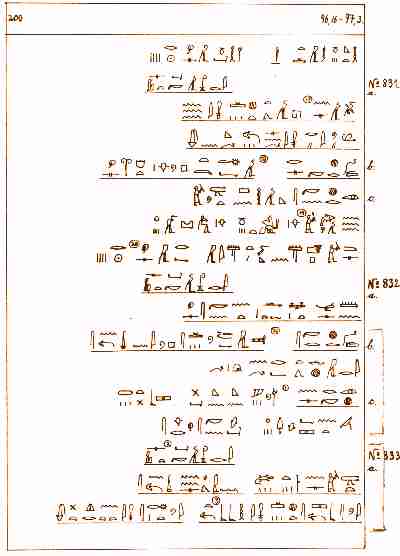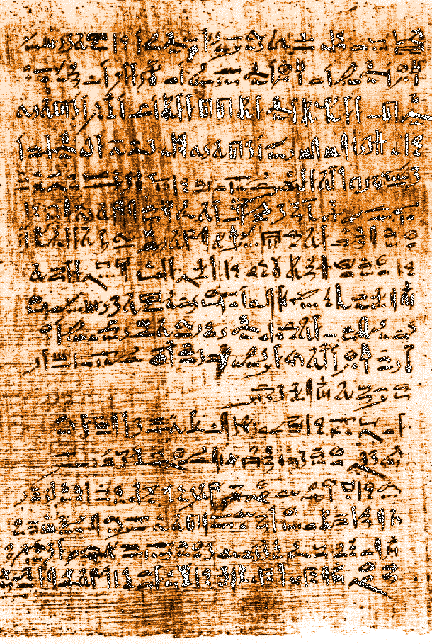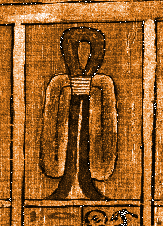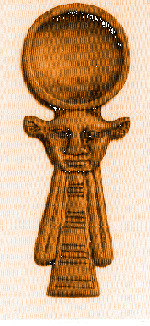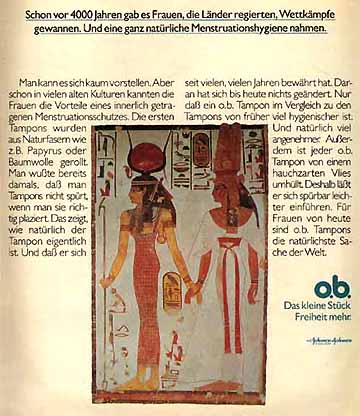Traveling within the World
Linking your favorite traveling artists across the globe
Menstruation, Menstrual Hygiene and Woman's Health in Ancient Egypt by Petra Habiger
©1998 Petra Habiger
 |
 |
One of the most important milestones of the history of mankind is the development of writing. It is the written language which helps give us evidence of ancient cultures, and subjects such as menstruation.
Many myths accord menstrual blood a life-giving nature:
Some South American Indians, for instance, thought that all mankind was created out of "moon blood."
The Mesopotamian mother goddess Ninhursag was said to make men out of loam and her "blood of life." She taught women to make loam dolls for use in a conception spell by painting them with their menstrual blood.
In the Bible's "Genesis" the name Adam is derived from "adamah," which can be translated as "bloody loam."
Many associate the moon with menstruation. The Babylonians, Romans, Indians and Moslems based their calendar systems on the lunar year.
In many civilizations the moon god is female (Ishtar (Assyrian/Babylonian), Quilla (Inca), Dschan (Thailand), Selene (Greece), Luna (Roman Empire), and very often the moon goddess is as well the goddess of fertility and motherhood. Furthermore, the crescent moon was in many cases associated with a virgin goddess like the Greek Artemis or the equivalent Roman Diana and later with the Virgin Mary. The Roman goddess Juno was also associated with the new moon.
In ancient Egypt the moon was closely tied to the ibis-headed god Thot, who was also regarded as the inventor of writing. A pyramid inscription of 2300 B.C. makes the moon equal to Tefnut, the daughter of the creator god Atum. Then, during the Greek-Roman period (3rd cent.-4th cent. C.E.) the Egyptian Nechbet was associated with the Greek moon goddess Selene. In a small temple of Ramses II in Abydos archaeologists found for the first time a picture of a female moon godhead. As far as Egypt is concerned, we can at least speak of a gradual "feminizing" of the moon through the centuries.
Fertility was very early attributed to the moon.
Egypt was a male-dominated society. But although public life was men's domain, and their wives' tasks were mostly private, public administrative functions among women had been common during the Old Kingdom (before 2155 B.C.E.).
Although research about women in antiquity is still in its infancy, the first evidence for menstruation has come down to us from ancient Egypt.
Linguistics
As far as I know menstruation was not the subject of any relief graphics. But there are some very interesting passages in ancient texts about it.
The old Egyptian word for menstruation was hsmn, presumably pronounced "hesmen." But that is not certain, because vowels were usually left out.
The hieroglyph hsmn, menstruation, short version |
hsmn, the spelling of a later period (1) (see the numbered notes at the end of the article) |
The decoding of hieroglyphics is made more difficult because they could be written either from top to bottom or vice versa, or from right to left or the other way around. The Egyptians loved beauty and pleasing proportions in many facets of their life, and would alter their writing for to satisfy this desire. (See also the essay of Dr. Friederike Schneider, "Personal Hygiene in Ancient Egypt.")
Taboo
An inscription at the Hathor temple in Edfu contains a list of gods with their specific dislikes. One god disliked menstruating women.
Some Egyptologists tend to assume that there had been strong taboos against menstruation in certain temples but these taboos were not universal. And there is no evidence for menstrual taboo as we know nowadays, though the story of the "laundry man" (described later) can be seen as a negative example.
Menstruation was treated ambiguously, because menstrual blood was generally considered to have a healing effect and was used for producing drugs, ointments, etc., as described in the so-called medical/magic papyri (2); but not for men.
Women's Health
The first case I talk about here comes from the Papyrus Kahun, which was written during the Middle Kingdom period (ca. 1850 B.C.E.), and starts with a diagnostic history that suggests that a physical examination as well as a description of symptoms have already taken place:
Medicine [for a woman whose eyes] are bad so that she cannot see and whose neck hurts.
Then you should say: There is material in her eyes overflowing from her uterus.
Then you should do [the following] against it: you should expose her to the vapor of frankincense and fresh oil; you should expose her vulva to those vapors; you should expose her eyes to the vapor of oriole thighs, then you should see that she eats fresh donkey liver.
The donkey was often put on a level with that incorporation of evil, the god Seth; eating its liver symbolized the weakening or extermination of this god.
Another case deals with pain around the anus, pubic region and the top of the thighs and is attributed to uterine discharge and treated by a special drink.
Perhaps the text is talking about a vaginal ringworm which may cause an inflammatory skin rash.
Some other cases ascribe incontinence and even pain in the feet and legs after walking to uterine discharge. [Many American patent medicines in the 19th and early 20th centuries claimed to cure uterine complaints; many doctors and laymen saw the womb as the source of women's problems.]
Let's continue with the Papyrus Ebers (3), written in the New Kingdom period (1550-1450 B.C.E.), of which copies were used until Persian times (4th cent. B.C.E.) so that translations into Greek exist from which a good interpretation is possible.
Here we find something about uterine bleeding:.
If you examine a woman who has had a discharge like water and the end of it is similar to baked blood, then you should say: This is a scrape in her uterus. Then you should make her: Nile earth from the water carrier, which you crush in honey and galena; put this on a dressing of fine linen and insert it into her vagina for four days.
The translator Wolfhart Westendorf thinks that this passage is about menstruation and believes Seth to be originator of the bleeding wound. But what can really cause a wound in the uterus except a mythological godhead? Would a menstruating women consult a doctor only to obtain menstrual hygiene? And why is a medical ointment used together with the tampon?
The text reminds us of a very heavy flow called "hypermenorrhea," which occurs with clots of coagulated ("baked") blood. But tumors can be the reason for such heavy flows.
Another passage says:
If you examine a women who suffers from the side of her pubic region, then you should say: This is an irregularity of her menstruation.
A dressing with a mixture of chopped onions, mash and pine sawdust should remedy this.
Another case describes a woman who did not menstruate for years; she vomits "something like river water all the time and her belly is under fire." All this is considered to be a "build-up" of the blood in the uterus. The woman should drink a cocktail of gin berries, caraway, frankincense and a certain reed [Cyperus esculentes] for four days.
Papyrus Ebers
Excerpt from the Papyrus Ebers, a transcription by Walter Wreszinski |
In some medical recipes of the Papyrus Ebers, menstrual blood is used as ingredient.
Sagging breasts, for instance, "should be covered with menstrual blood and the woman's belly and her thighs covered as well."
Another very informative text is the Edwin Smith Surgical Papyrus (4), written about the same time.
Besides some beauty mixtures it contains three prescriptions for women's illnesses that are obviously a suspension or interruption of menstruation:
(Above) Excerpt from the Papyrus Edwin Smith; you can see the word hsmn, menstruation, at the end of the first line, which is written from right to left. This so-called "hieratic script" is the result of a simplification of the confusing conglomeration of hieroglyphs at about 2900 B.C.E.
Above is a transcription of the same text fragment by James Henry Breasted; note the word hsmn at the end of the second line.
If you examine a woman suffering in her abdomen, so that the menstrual discharge cannot leave her; and you notice something in the upper part of her vulva: Then you should say: This is a blockage of blood in her womb.
Then you should make for her [a mixture of]: fruit (5), 20 parts; oil/fat, 1/8; sweetened beer, 40 parts; it should be cooked and then imbibed for four days.
Then you should make her a laxative for the blood: pine oil; caraway; galena; sweet, aromatic myrrh resin; it should be cooked until a homogeneous consistency is achieved and then her pubic region should be repeatedly rubbed with it.
Additionally you should administer hyena-ear (6) in oil/fat as follows: After it is rotten you should massage her pelvis region repeatedly with it. Then you should put some myrrh resin and frankincense between her thighs and let the vapours penetrate her vulva.
At a first glance this prescription appears strange and I was curious to know what a gynecologist of today would say about it.
For Prof. Jael Backe, M.D., of the University of Würzburg, Germany, for instance, the recipe is not comprehensible, although there are some parallels to present-day medicine. In her opinion the diagnosis at the beginning of the papyrus text has to be divided into two parts.
The key sentence for the first part is "so that the menstrual discharge cannot escape," indicating a cessation of menstruation (amenorrhea), which is mostly caused by disorders of the central nervous system because of psychological reasons (stress, sorrow etc.) or physical overexertion. Today's treatment would be herbal medicine.
If we regard the ingredients of the ancient recipe from this aspect it strikes us that mostly volatile oils and plants are used which have today proved effective on the central nervous system!
The second part of the diagnosis, "something in the upper part of her vulva," suggests the existence of warts or something similar on the vulva which have nothing to do with amenorrhea but can be also treated by herbal medication.
So you see there might be a slight correlation between today's treatment and that of ancient Egypt.
This passage of the Papyrus Edwin Smith, above, contains the word hsmn, menstruation, at the end of the 13th line, which is written from right to left.
Menstrual Blood
Menstrual blood was supposed to have a cleansing effect [this theory persists today, for example in the ideas of Margie Profet]. A good example is a passage in a story about Prince Setne Chaemwaset in which his wife Ahwere describes her pregnancy by the cessation of her menstruation: "When my time of cleansing came, I was able to cleanse no more."
Pregnancy
At this time people had a rather good picture of pregnancy, knowing its length and that menstrual cessation was a possible sign of pregnancy.
There exist certain receptacles made from alabaster that probably contained oils that pregnant women used to prevent stretch marks. These receptacles are shaped like a naked human body but lack genitalia. Were they also a magic protection against premature births?
In some "Spells for Mother and Child" menstrual blood is used as an ointment to protect newborn from demons.
Some medical texts obviously contain contraception remedies. Perhaps not all had been successful but the insertion of substances like honey or crocodile dung into the vagina could have effectively blocked a male's semen because of its thick consistency. One recipe talks of pulverized acacia spikes, which contain gum Arabic, and that actually have a chemical effect on sperm and actively retard conception. And breast feeding babies up to their third year would also hinder pregnancy.
A red gemstone served as a contraceptive amulet and as a sign that flowing menstrual blood precluded a pregnancy (7).
Menstrual Hygiene
Up to now, there have been no artifacts showing any sort of menstrual hygiene in ancient Egypt. But there is a laundry list from which some researchers infer the existence of pad, belt and tampon-like items, but translating from lists is a tough job.
Today about 95% of the hieroglyphs are translated; for the rest, researchers try to translate from the context.
The translation of a word is regarded as certain when it can be derived from at least three different contexts. Because of the few texts available at the end of the last century when the Dictionary of Egyptology was prepared, the existence of pads and tampons is not proved though such items must have existed.
In a "Wisdom Text" there's one more indirect hint about menstrual hygiene. The text describes the high social status of a scribe and also gives some examples of "negative" careers like that of a laundry worker, who even has to wash the "loincloth of a menstruating woman," which could easily be a pad with belt or something similar. This story also again implies that menstrual blood was impure and was something a respectable man didn't touch. And, indeed, there is no evidence for the use of menstrual blood as a remedy for men.
In Roman Egypt circumcision of men and women was widespread. Even the total removal of a woman's clitoris was common, as a Greek text of Aëtius tells us (8).
In order to stop the bleeding after this surgery a kind of pad was used, made from a compress with a sponge on top. Similar designs might have been also utilized to absorb menstrual blood.
There is one example of such above-mentioned pregnancy receptacles showing a kind of tampon inserted into the vagina, probably to catch the blood of a potential miscarriage. It has now been assumed that the so-called tyet or Isis knot often used as a protector talisman originally was such a tampon used by the goddess Isis while she was pregnant with Horus; the god Seth had tried to destroy the baby in her womb many times, sometimes by causing premature bleeding.
Others suggest that the Isis knot, a stone carving portraying a cloth that has been rolled up and looped around itself, represents a menstrual tampon.
As flax was cultivated and even exported to other countries, cheap linen could qualify as a raw material for the tyet and be used by even the poorer groups of people.
Image of a tyet taken from the Book of the Dead of Ani (ca. 1250 B.C.E.), British Museum, London |
Tyet-shaped wooden salve spoon with Hathor head, Berlin, Inv.Nr. 1178 (9). |
Nevertheless it is generally assumed that ancient Egyptian women fashioned a kind of throw-away tampon probably from papyrus or other grass; during the Roman era cotton probably took the place of these materials, which is also today's component of that kind of menstrual hygiene. This fact was utilized by contemporary tampon manufacturers to combat the widespread opinion that pads are more natural and proven in use. Showing that tampons were used in ancient Egypt is supposed to convince women that that is not true.
Here's an o.b. tampon ad taken from the German Burda magazine from the year 1989:
The ad shows the papyrus plant (cyperus papyrus).
Translation:
This is how a 4000-year-old invention looks today.
Tampons are almost as old as earth itself. Because there were always women who, of course, used an internal menstrual protection.
The first tampons were handmade from leaves or natural fibers. Today too tampons are manufactured from natural materials. But in contrast to the past an o.b. tampon is far more hygienic and reliable. Now we are able to make this great invention even better.
Every o.b. is covered with a very delicate, soft fleece. This makes it smoother and more able to slide. Therefore it can be inserted noticeably easier. Even for light flow or at the end of the period changing the tampon is very easy. So easy that today so many women think o.b. tampons are one of the world's best inventions.
o.b. - the small piece of additional freedom
The ad has a very clever structure.
At first tampons are generally introduced as something very natural and proven. Even 4000 years ago "women of course used an internal menstrual protection." The transition to our century is also very general, because there are other brands, too, which consist of natural fibers. Then there comes the key sentence where the reader should unconsciously be convinced that o.b. tampons are superior to other brands without really mentioning this ("But in contrast to the past an o.b. tampon is far more hygienic and reliable.") However, what makes o.b. superior is not mentioned. Why is it more hygienic and reliable? What danger does the word "reliable" hint at?
And something is omitted: where the tampon can be inserted easier.
Last but not least, changing the tampon is "So easy that today so many women think o.b. tampons are one of the world's best inventions." That means that the handling is as easy as that of a pad with which the tampon must compete.
The following o.b.-ad might also be from the 1980s.
Translation:
Four thousand years ago there were already women ruling countries, winning competitions. And using a completely natural menstrual protection.
It is almost unbelievable. But in many ancient cultures the women knew about the advantages of an internal menstrual hygiene. The first tampons were made by rolling up natural fibers such as papyrus or cotton. Women already knew that they couldn't feel them if they were inserted correctly. This shows how natural the tampon actually is. And that it has proved itself for many, many years. Nothing has changed. Only that an o.b. tampon is much more hygienic than the earlier ones. And of course more comfortable. In addition, each o.b. has a very thin fleece covering. Therefore it can be inserted noticeably easier. For today's women tampons are the most natural thing in the world.
o.b. - the small piece of additional freedom
For this ad a picture is used that creates the connection to antiquity in order to prove the allegation of the existence of tampons in ancient Egypt. The richly colored image, showing two women walking hand in hand, looks impressive. It suggests scientific competence that is actually not immediately verifiable by the reader.
But the picture has nothing to do with tampons at all! It shows a scene from the tomb of Nefertari in Thebes (10). Neferati (right), the "great royal spouse the king truly loves" - clad with the formal dress of the first royal wife -, is taken by the hand by the goddess Isis, who leads her to the next world. (Wags could maintain that if the picture has something to do with tampons, then it must refer to toxic shock syndrome!)
The only thing that connects the ad picture with menstruation is the goddess Isis herself.
Like the Babylonian Ishtar, Isis incorporated the personalities of several minor goddesses until she was elevated to be universal goddess of Egypt as well as other peoples. She was also called Goddess of the Ten Thousand Names. The Isis cult, which could be almost regarded as a monotheistic religion, was spread over the whole Mediterranean and was even practiced in the German Rhine region! Isis, Osiris's sister, whose death she lamented, thereby entering into the ritual of the dead, was thought to have magical powers. She was considered to be the giver of health and she personified femininity, teaching women to grind corn, weave clothes and tame men enough to be able to live together with them. [!]
But Isis could be understood as the inventor of the first tampon if we presuppose that the Isis knot (see above) served as such an object.
Today we can probably assume that both tampons and pads were used in ancient Egypt. There is no evidence as to which was preferred.
Women's Social Position
Compared to other ancient cultures women's status in Egypt was pretty independent. In accordance with the Ma'at, the Egyptian principle of order, theoretically no differences existed between men and women.
We don't actually know how much this was reflected in real life.
One thing is for certain: Egyptian women and men had been equals with regard to the laws of contract, capital and divorce. Because of his economical superiority, however, men could claim more rights.
But with regard to foreigners, who had no rights concerning life or ownership at all, the situation is clear.
And for sure today's Muslim women have by far fewer rights and social protection than women in antiquity.
Concluding Remark
There are some discrepancies in the old texts; look at the Westendorf translation of the Papyrus Ebers. There must also be more evidence about menstrual hygiene that can be discovered. But perhaps in the past there was no need to verify or even cast doubt upon the conception of the world characterized by male norms.
We already know that the "Egyptian Dictionary" was published at the very beginning of this century and the material for it had been collected only up until the end of the 19th century. Sources found or published after the 1909 deadline influence current work little if at all. But as Erich Kästner said, schoolbooks were not written on Mount Sinai!
On the contrary, mostly secondary literature today is cited. Current textbooks had been written by our grandparents who on their part again copied what others had written . . . and so on.
But there might be light at the end of the tunnel. Today about 70 percent of all Egyptology students here in Germany are female and they will probably with time hold a similar number of professorships. And this should be the same in other countries.
So it rests with women, if they can or are willing, to change this picture of menstruation (and not only this) in the future.
At left is papyrus, one of the most important exports of ancient Egypt. The Egyptians carefully protected the secret of its manufacture. Our word paper derives from it.
If you have questions about this essay or about menstruation or menstrual hygiene in general, don't hesitate to contact me via e-mail. Thank you also for criticism and ideas.
Notes:
(1) Spelling according to Erman/Grapow, beginning of the century
(2) As you see, in ancient times medicine and magic had been closely melded. This didn't change until the age of the European renaissance when science arose and people slowly began to study and understand human bodies.
(3) The Papyrus Ebers, named after the Egyptologist Georg M. Ebers (1837-1898), was written in the so-called New Kingdom period (1550-1450 B.C.E.) and is probably based on former sources.
(4) The Edwin Smith Papyrus is named for an American antiques dealer (1822-1906); it was also written in the New Kingdom period but based on earlier sources.
(5) According to Prof. Dr. Wolfhart Westendorf, the fruit of an unknown plant
(6) Name of a plant
(7) Here it is definitely clear: At this time it was known that it was almost impossible to get pregnant while menstruating, a knowledge which was lost again later as the ancient Greeks considered menstruation to be the best time for getting pregnant. This fallacy remained until the 19th century (I will show this in later reports about Greece in antiquity, etc.)
(8) Aëtius, 6. cent. B.C.E.
(9) Site of discovery: West Thebes, tomb of Queen Mentuhotep, 17th dynasty, about 1600 B.C.E.
(10) Thebes, Valley of the Queens, so-called vestibule
THANK YOU NOTE:
Very special thanks to Orell Witthuhn, from the Philipps University, Marburg, Germany, who fundamentally contributed to the success of this report with his quick and valuable assistance and a remarkable knowledge.
I also received valuable encouragement and assistance from Prof. Dr. Jael Backe from the University of Würzburg and Dr. Terry G. Wilfong, Assistant Professor of the Egyptology Department of Near Eastern Studies and Assistant Curator for Graeco-Roman Egypt at the Kelsey Museum of Archaeology of the University of Michigan in Ann Arbor.
SOURCES:
British Museum, London
The Edwin Smith Surgical Papyrus, Rs 20,13-21,3, translated by James Henry Breasted, The University of Chicago Press, 1930
A. Erman, Zaubersprüche für Mutter und Kind
Der Große Brockhaus, Kompaktausgabe, 18. Auflage, F. A. Brockhaus, Wiesbaden
R. Hall, Egyptian Textiles, Aylesbury, 1986
Wolfgang Helck, Eberhard Otto, Lexikon der Ägyptologie, Otto Harrassowitz, Wiesbaden, 1992
Mary R. Lefkowitz, Aëtius on Clitoridectomy, Wellesley College, 1998
Miriam Lichtheim, Ancient Egyptian Literature, University of California Press, 1980
Patricia Monaghan, Lexikon der Göttinnen, Scherz Verlag, 1997
Gay Robins, Frauenleben im alten Ägypten, C.H. Beck'sche Verlagsbuchhandlung München, 1996
Setne I is preserved in the Cairo Museum Papyrus No. 30646
Papyrus Edwin Smith, Rs 20,13-21,3, translated by Prof. Dr. Wolfhart Westendorf, Verlag Hans Huber, Stuttgart
William A. Ward, The Egyptian Economy and Non-royal Women: Their Status in Public Life, NEH Lecture, Brown University, 1995
Renate Waschek, Dieses kleine Stück Watte . . ., Werner Pieper's MedienXperimenrte, Löhrbach, 1991
Wolfhart Westendorf, Erwachen der Heilkunst: Die Medizin im Alten Ägypten, Artemis & Winkler, 1992
Walter Wreszinski, Papyrus Ebers Umschrift, Übersetzung und Kommentar, J. C. Hinrichs'sche Buchhandlung Leipzig, 191
©1998 Petra Habiger
Tags:
Replies to This Discussion
Events
-
2014 is the Chinese Year of the Horse
February 17, 2026 at 12am to February 5, 2027 at 12am – where & how you choose
Birthdays
Birthdays Today
Important (read & understand)
Skype: Travelingraggyman
Email and Instant Messenger:
TravelerinBDFSM @ aol/aim; hotmail; identi.ca; live & yahoo
OR
Travelingraggyman @ gmail and icq ***

1AWARD UPDATES & INFORMATION
10,000 votes - Platinum Award
5,000 votes - Gold Award
2,500 votes - Silver Award
1,000 votes - Bronze Award
300 votes - Pewter Award
100 votes - Copper Award
Member of the Associated Posting System {APS}
This allows members on various sites to share information between sites and by providing a by line with the original source it credits the author with the creation.
Legal Disclaimer
***************We here at Traveling within the World are not responsible for anything posted by individual members. While the actions of one member do not reflect the intentions of the entire social network or the Network Creator, we do ask that you use good judgment when posting. If something is considered to be inappropriate it will be removed
Site Meter
This site is strictly an artist operational fan publication, no copyright infringement intended
Patchwork Merchant Mercenaries had its humble beginnings as an idea of a few artisans and craftsmen who enjoy performing with live steel fighting. As well as a patchwork quilt tent canvas. Most had prior military experience hence the name.
Patchwork Merchant Mercenaries.
Vendertainers that brought many things to a show and are know for helping out where ever they can.
As well as being a place where the older hand made items could be found made by them and enjoyed by all.
We expanded over the years to become well known at what we do. Now we represent over 100 artisans and craftsman that are well known in their venues and some just starting out. Some of their works have been premiered in TV, stage and movies on a regular basis.
Specializing in Medieval, Goth , Stage Film, BDFSM and Practitioner.
Patchwork Merchant Mercenaries a Dept of, Ask For IT was started by artists and former military veterans, and sword fighters, representing over 100 artisans, one who made his living traveling from fair to festival vending medieval wares. The majority of his customers are re-enactors, SCAdians and the like, looking to build their kit with period clothing, feast gear, adornments, etc.
Likewise, it is typical for these history-lovers to peruse the tent (aka mobile store front) and, upon finding something that pleases the eye, ask "Is this period?"
A deceitful query!! This is not a yes or no question. One must have a damn good understanding of European history (at least) from the fall of Rome to the mid-1600's to properly answer. Taking into account, also, the culture in which the querent is dressed is vitally important. You see, though it may be well within medieval period, it would be strange to see a Viking wearing a Caftan...or is it?
After a festival's time of answering weighty questions such as these, I'd sleep like a log! Only a mad man could possibly remember the place and time for each piece of kitchen ware, weaponry, cloth, and chain within a span of 1,000 years!! Surely there must be an easier way, a place where he could post all this knowledge...
Traveling Within The World is meant to be such a place. A place for all of these artists to keep in touch and directly interact with their fellow geeks and re-enactment hobbyists, their clientele.
© 2025 Created by Rev. Allen M. Drago ~ Traveler.
Powered by
![]()
